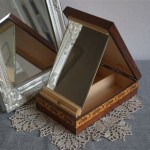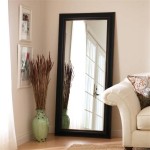How to Decorate Mirrors: Enhancing Spaces with Reflective Art
Mirrors, beyond their functional purpose, serve as versatile decorative elements capable of transforming the ambiance of any room. Their reflective properties amplify light, create the illusion of spaciousness, and add visual interest. Decorating mirrors allows for personalization, enabling integration with existing décor styles and the expression of individual aesthetic preferences. This article explores various techniques and considerations for effectively decorating mirrors, thereby maximizing their impact on interior design.
Selecting the appropriate mirror for decoration is the initial crucial step. Factors to consider include the mirror's size, shape, and placement within the room. A large, ornate mirror in a living room can act as a focal point, while smaller, decorative mirrors can complement existing artwork or furniture arrangements. The existing décor style should also inform the selection process. A minimalist room may benefit from a mirror with a simple, clean frame, whereas a more traditional space might accommodate a mirror with an elaborate, antique-inspired design.
The purpose of the decoration should also be considered. Is the aim to enhance the mirror's existing frame, or to create a completely new look? This will influence the choice of materials and techniques employed. Permanent decorations may require careful planning and execution, while temporary embellishments offer flexibility and ease of alteration. Understanding these fundamental aspects lays the groundwork for successful mirror decoration.
Frame Enhancement Techniques
One of the most effective methods for decorating mirrors involves enhancing or altering the existing frame. This can be achieved through a variety of techniques, ranging from simple painting to more complex embellishments. Before commencing any frame decoration, it is essential to thoroughly clean the surface of the frame with a suitable cleaner, ensuring it is free from dust, dirt, and grease. This preparation ensures proper adhesion of paints, adhesives, and other decorative materials.
Painting the mirror frame offers a simple yet impactful way to transform its appearance. The choice of paint should be determined by the material of the frame. Wood frames can be painted with acrylic or enamel paints, while metal frames may require specialized metal primers and paints to prevent corrosion. Consider the existing color palette of the room and select a paint color that complements the décor. A contrasting color can create a bold statement, while a complementary color can provide a more subtle and harmonious effect. Multiple coats of paint may be necessary to achieve full coverage and a durable finish. Allow each coat to dry completely before applying the next.
Adding decorative elements to the frame provides another avenue for enhancement. This can involve gluing on items such as seashells, mosaic tiles, beads, or even small pieces of driftwood. The adhesive used should be appropriate for both the frame material and the decorative elements. Hot glue guns offer quick and strong adhesion for many materials, but epoxy adhesives may be more suitable for heavier or more delicate items. When applying decorative elements, consider the overall design and spacing. A symmetrical arrangement can create a formal and elegant look, while an asymmetrical arrangement can offer a more contemporary and eclectic feel.
For a rustic or bohemian aesthetic, consider wrapping the frame with rope, twine, or fabric strips. Secure the material with glue or staples, ensuring a tight and even wrap. This technique can be customized to suit various styles by using different types of rope or fabric, such as jute twine for a natural look or colorful fabric scraps for a whimsical touch. The ends of the rope or fabric should be neatly trimmed and secured to prevent unraveling.
Direct Mirror Surface Decoration
Decorating directly on the mirror's surface presents a unique set of opportunities and challenges. This approach allows for the creation of intricate designs and personalized messages directly on the reflective surface. However, it is crucial to use materials that are specifically designed for use on glass and that will not damage the mirror's reflective coating.
Glass paint markers are a popular choice for decorating mirrors. These markers contain opaque paints that adhere well to glass surfaces and are available in a wide range of colors and tip sizes. Before using glass paint markers, it is advisable to test them on a small, inconspicuous area of the mirror to ensure they do not damage the surface. When drawing on the mirror, apply light pressure and allow the paint to dry completely before adding additional layers. Stencils can be used to create precise designs or lettering. To remove the paint, use a glass cleaner or a mild solvent, carefully wiping away the design without scratching the mirror.
Another option for direct mirror decoration is the use of adhesive vinyl decals. These decals are available in various shapes, sizes, and colors and can be easily applied and removed without leaving residue. Vinyl decals are particularly useful for creating temporary decorations or for adding personalized messages to the mirror. Ensure the mirror surface is clean and dry before applying the decal. Carefully peel the decal from its backing and position it on the mirror. Use a squeegee or a credit card to smooth out any air bubbles and ensure the decal adheres firmly to the surface.
Etching cream can be used to create permanent designs on the mirror's surface. This technique involves applying a chemical cream that corrodes the glass, creating a frosted effect. Etching cream should be used with caution, as it can be corrosive to skin and other surfaces. Always wear gloves and eye protection when working with etching cream. Apply a stencil to the mirror surface to protect the areas that are not to be etched. Apply the etching cream evenly over the stencil, following the manufacturer's instructions. Allow the cream to sit for the recommended time, then rinse it off thoroughly with water. Remove the stencil to reveal the etched design.
Incorporating Lighting and Accessories
Integrating lighting and accessories can elevate the decorative impact of mirrors, creating a more visually appealing and functional space. Strategic placement of lighting can enhance the mirror's reflective properties, amplifying light and creating a brighter and more inviting atmosphere. Accessories can be used to complement the mirror's design and to personalize the surrounding area.
String lights are a versatile and cost-effective way to add a touch of whimsy and warmth to mirror decorations. Drape the string lights around the frame or behind the mirror to create a subtle and ambient glow. Battery-operated string lights offer greater flexibility in placement, as they do not require access to an electrical outlet. Choose from a variety of light colors and styles to suit the room's décor. Warm white lights create a cozy and inviting atmosphere, while colored lights can add a playful and festive touch.
Sconces and vanity lights can be mounted on either side of the mirror to provide focused lighting for grooming or makeup application. These lights should be positioned at eye level to minimize shadows and provide even illumination. Consider the style of the sconces or vanity lights and choose fixtures that complement the mirror's design and the overall décor of the room. Dimmable lights offer greater control over the brightness and can be adjusted to suit different needs and preferences.
Accessories such as candles, vases, and decorative objects can be placed near the mirror to enhance its visual appeal. Arrange the accessories in a balanced and visually pleasing manner, taking into account the mirror's reflection. For example, placing a vase of flowers in front of the mirror will create the illusion of a larger bouquet. Candles can be placed on a shelf below the mirror to create a warm and inviting ambiance. Choose accessories that complement the mirror's design and the overall style of the room.
By carefully considering these techniques and considerations, individuals can effectively decorate mirrors to enhance their aesthetic appeal and transform their living spaces. The possibilities are limited only by imagination and creativity.

How To Decorate With Mirrors 25 Mirror Decorating Ideas

Beautiful Mirror Decoration Ideas With Simple Flowers And Lights Diy Flower Mirrors
:max_bytes(150000):strip_icc()/mirrorandsidetable-479a3c1349614b96bedbdc7529698426.jpg?strip=all)
25 Mirror Decor Ideas To Brighten Your Space

How To Decorate With Mirrors Ideas Advice Lamps Plus

How To Decorate Around A Mirror

How To Decorate With Mirrors Diy Blog

How To Decorate With Mirrors A Dos Don Ts Guide Luxe

Mirror Decorating Ideas How To Decorate At Home Decoration

Mirror Décor Ideas How To Decorate With Mirrors
:max_bytes(150000):strip_icc()/118914680_348088313225832_6514047279381283704_n-dce6c6f4f04146bfba4837327d48fcd5.jpg?strip=all)
Expert Tips For Decorating With Mirrors








